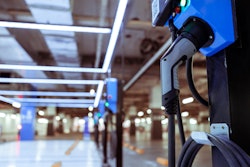Earlier this year, the American Transportation Research Institute released the results of research on the full lifecycle emissions of electric trucks compared to a traditional diesel engine and other alternative fuel powertrains.
This month, ATRI followed up that report with the results of more research focused on the infrastructure challenges of EV adoption. To identify the most critical challenges, ATRI reviewed all aspects of vehicle electrification with a focus on trucking. The results of that research turned up three key infrastructure-related challenges that will impact truck electrification: U.S. electricity supply and demand, electric vehicle production, and truck charging requirements.
Jason and Matt are joined on this week's 10-44 by Jeff Short, vice president at ATRI, who talks about the results of the research and gets to the bottom of how much electricity will really be needed to power not only the U.S. trucking industry, but the nation's entire vehicle fleet.
Contents of this video
00:00 Truck electrification
3:30 Electricity supply and demand
5:08 Sourcing raw material for lithium-ion batteries
8:23 Mining raw materials in the U.S.
9:06 Charging electric trucks
10:45 Transitioning fleets to electric
Matt Cole: The move to electric vehicles, particularly trucks, in the US, presents numerous challenges, including electricity supply and demand, EV production and charging requirements.
Jason Cannon: Hey everybody, Merry almost Christmas and welcome back to the 10-44, a weekly webisode from the editors here at CCJ. I'm Jason Cannon, and my co-host on the other side is Matt Cole. Earlier this year, the American Transportation Research Institute released the results of research on the full life cycle of emissions of electric trucks compared to a traditional diesel engine and other alternative fuel power trains. This month, ATRI followed that report up with the results of more research that focused on the infrastructure challenges of EV adoption.
Matt Cole: To identify the most critical challenges, ATRI reviewed all aspects of vehicle electrification with the focus on trucking. The results of that research turned up three key infrastructure related challenges that will impact truck electrification. US electricity supply and demand, electric vehicle production, and truck charging requirements. We are joined by ATRI vice president Jeff Short, who talks about the research and the uphill climb the US faces with vehicle electrification.
Jeff Short: Our research advisory committee, they saw last year that truck electrification was an increasingly important topic, enough so that two EV related research studies were selected as top priorities. The first study, which came out in May, looked at vehicle CO2 emissions, comparing an electric truck with a traditional truck and found only a 30% decrease in CO2 could be realized across the long haul vehicle's lifecycle, but that includes building the battery, that includes running the vehicle for a million miles and so on and so forth. So it was only a 30% decrease. That was really looking at the truck itself.
The goal of this more recent research was to assess the infrastructure requirements of the trucking industry and of electrification of the industry. In quantifying those requirements, we ultimately offered insight into the near term feasibility of truck electrification. There's a lot of information out there regarding what will and will not work for trucking, and what we did was find quantifiable answers to many of the questions that have been floating around for years.
The first challenge is generation of electricity, of course. For trucking, energy must be reliable, affordable, and available. The price must be predictable and not widely fluctuate throughout the day. With all that said, EVs are going to put enormous amount of demand on utilities, which could be problematic. A second challenge is the materials needed to make the actual electric truck, in particular to make the batteries. We look at the supply and demand of critical materials that included cobalt, lithium, graphite, nickel. Found that a staggering amount of material is needed just for the US fleet. That's the trucking fleet and for cars as well, and there's global demand to contend with as well as that. Third challenge lies with long haul truck charging. As you know, there's already a huge problem in the US with the truck parking shortage. It is perennially identified by drivers as a top concern through our annual top industry issue survey. So finding a truck parking space is often difficult. Finding a truck parking space with a charger is going to be an entirely different ballgame.
Jason Cannon: As Jeff mentioned, EVs are going to put a ton of pressure on the existing power grid and utility companies. Leading to the first challenge at ATRI found, electricity supply and demand.
Jeff Short: As many of you've heard, we found that US electricity infrastructure is on the older side. It's often exposed to events that cause outages. They could be weather events, manmade events like we had in the past week. At the same time, demand for electricity is going to explode with full electrification. Our calculations indicate that electric vehicle electricity demand itself for all vehicles in the US will equal 40% of what is produced today. If we were to replace the entire US vehicle fleet instantly, we will have 40% more consumption, which means we need to make more electricity.
For trucking specifically, utilities across the country will need to produce more than 500 billion kilowatt hours annually. That for trucking alone is 14% of the electricity generation. Long haul trucks, they will require about 10% of today's electricity. That's because trucks are heavier. They rack up large mileage figures each year. A car might get 10,000 miles a year. Trucks may be in the range of a hundred thousand or more each year. So what can be done, ultimately that lies with the utilities. The trucking industry doesn't make electricity, they are the experts in getting that much energy out there. We just want to be sure that it's clear how much these trucks are going to demand, as well as the cars in the US.
Matt Cole: The lithium-ion batteries that are used to power electric vehicles present another challenge for transitioning the US vehicle fleet to electric. Large scale production of these batteries will require a new vehicle related set of supply chains, ATRI found. Including expanding mining and processing of raw materials, battery manufacturing and more.
Jeff Short: Trucking needs tons of battery materials. Millions of tons of battery materials like lithium, like cobalt. These materials need to be explored for, they need to be mined, they need to be processed, manufactured into a working lithium ion battery. All of that takes time. There is pollution associated, especially with the mining side and final processing of the mine materials. These are tasks that take place all over the world. China, for instance, produces three quarters of the world's finished lithium-ion batteries. China sources those raw materials, however, from very specific places in Africa, Australia, South America. Ultimately due to the lack of diversity in sources, supplies of batteries are vulnerable. Price fluctuations are definitely a concern as a result of that. It's important to understand that battery electric trucks are two or three times the cost of the traditional truck and the majority of that cost is for the battery.
And trucking's not the only one who's going to be demanding these batteries. Cars in the US will place a huge demand on these materials as well. And then there's global demand as I mentioned earlier. Any disruption in the supply chain, can increase prices. We found that a given truck will need more than 300 pounds of lithium. What happens if the price per pound doubles or triples? It did this year. What happens if that continues? The battery costs will rise, and that's ultimately more capital that trucking companies going to need to plunge into equipment costs.
Jason Cannon: Many of the raw materials for lithium-ion batteries, as Jeff mentioned, are sourced from outside the US, ATRI notes, however that there has been a push by the Biden administration to mine key minerals in the US. Jeff talks about some of the potential for mining for raw materials stateside after a word from 10-44 sponsor Chevron lubricants.
Protecting your diesel engine and its aftertreatment system has traditionally been a double-edged sword. The same engine oil that is so essential to protecting your engine's internal parts is also responsible for 90% of the ash that is clogging up your DPF and upping your fuel and maintenance costs.
Outdated industry thinking still sees a trade off between engine and emission system protection and Chevron was tired of it, so they spent a decade of R&D developing a no compromises formulation. Chevron lubricants developed a new ultra low ash diesel engine oil that is specifically designed to combat DPF ash clogging. Delo 600 ADF with OMNIMAX technology cuts sulfate ash by a whopping 60%, which reduces the rate of DPF clogging and extends DPF service life by two and a half times.
And just think what you can do with all the MPGs you're going to add from cutting your number of regens. But Delo 600 ADF isn't just about after treatment. It provides complete protection, extending drain intervals by preventing oil breakdown. Before you had to choose between protecting your engine or your after treatment system, and now you don't. 600 ADF from Delo with OMNIMAX technology, it's time to kick some ash.
Jeff Short: There are some options in the United States for obtaining some of these materials domestically. The ultimate question is how much do we have? How much are we going to be able to mine ultimately and beyond that, are there going to be barriers? Because of the regulations in the United States, it may take a little longer. There may be some pushback perhaps from environmental groups on large scale mining operations because there is a lot of pollution and it does do damage to the earth, especially places where they're going to go in and it hasn't been mined yet, and certainly it's going to change the environment where the mining operation is placed.
Matt Cole: When it comes to actually charging electric trucks, there are a number of issues that present challenges, including drivers hours of service regs, the truck parking shortage and more.
Jeff Short: They're completely intertwined. When you find yourself beyond the wheel of an electric truck, you realize it's now essential to find a truck parking space that has access to charging. There's no longer the option of parking on an off-ramp or an unauthorized location if a truck parking location is at capacity. So once the driver finds the space to take his or her hours of service and charge and gain hours of service, they have to stay there. So the driver is still going to have to get consecutive rest time. So it may take, let's say it takes three, four hours of charging. They're still going to have to stay there for the rest period, so they're not going to be moving the truck so that someone else can access it. This ultimately exacerbates the truck parking places.
There's no way around it. Based on research, it's clear that each of the 313,000 truck parking locations in the US will need a charger. The problem is there's currently not enough parking and putting chargers at all of those locations won't even be enough charging. Ultimately, we will need more parking and more parking that has electricity access more than the 313. Not to mention the fact that you cannot have a commercial enterprise or charging, for instance at a public rest area. We mentioned that in the report and go into those details. Currently you're not allowed to do that. So that's at least 40,000 truck parking spaces that have a regulatory barrier to getting a charger at them.
Jason Cannon: The ultimate question then is, is it even feasible to transition the US vehicle fleet, particularly trucks to fully electric?
Jeff Short: It's something that takes time and remains to be seen if it's possible, but technology would alleviate some of the pressures associated with these issues. But ultimately, my final message here is the industry is not in the driver's seat on many of these challenges, though there are discussions of phasing out diesel trucks, requiring the purchase of zero emission trucks. The trucking industry does not produce electricity. We don't produce trucks, we don't produce chargers. We're the end user of these products. And ultimately, utilities, industry suppliers, OEMs, and truck stop operators are going to be the ones who need to provide feasible truck electrification options, a system that works for the industry. So it's a big effort and involves a lot of stakeholders, not just trucking.
Jason Cannon: That's it for this week's 10-44. You can read more on CCJDigital.com, and as always, you can find the 10-44 each week on CCJ's YouTube channel. And if you've got questions, comments, criticisms or feedback, please hit us up at [email protected] or give us a call at (404) 491-1380. And until next week, everybody have a Merry Christmas and stay safe out there.









